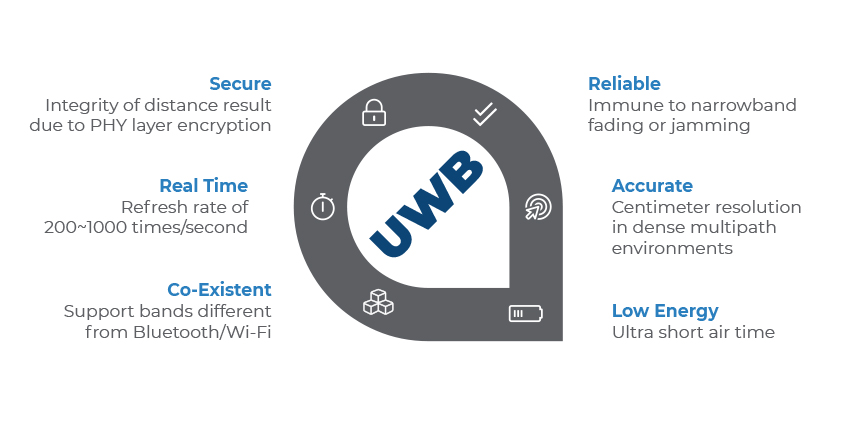Let’s say you’re at home and misplaced your car keys, or you’re in a grocery store and can’t find your favorite brand of coffee. Or maybe you’re working in a factory and need a particular tool from a storage bin, or you’re a site manager dealing with an emergency and need to make sure everyone’s exited the building. Indoor positioning helps in all these situations, because it can locate items and guide you to where they are.
The Importance Of “Where”
Knowing where an asset is located in real time is useful in many ways. In industrial settings, it improves item utilization rates and saves time spent searching for things. It opens the door for a new level of “just in time” efficiency on factory floors, and for inventory management in warehouses and retail environments. Safety is another benefit of accurate location, because knowing where people, automatic guided vehicles, and robots are in real time can help prevent accidents and keep people out of harm’s way. Accurate location in real time also enables contextual decision-making, so your smart house adjusts your stereo automatically as you move from to room or lets you control objects by simply pointing at them.
Lets you control objects by simply pointing at them
Security authorisations based on location is another possibility. Precise real-time location is something that can be hard to fake, so it can be used to restrict access to an area or used to add protections based on where an asset sits, where a piece of data resides, or the origination point of a communication.
Getting The Technology Right
Developing an effective technology for indoor positioning requires several things. To begin with, location readings needs to be very precise, with accuracy down to as small an area as possible. The technology has to be secure, because location often needs to be kept private. The technology has to be reliable, even in harsh environments, and easily scalable, too, so it can address the thousands of people and assets in large venues. It has to be low power and affordable, so it can be embedded in everything from high-end, complex devices like smartphones to low-end, simple devices like asset tags. And, of course, the technology has to have latency low enough that it can track movement in real time.
Various wireless technologies, including Bluetooth and Wi-Fi, are already used for indoor positioning, but they don’t deliver on the full set of requirements, especially in terms of accuracy. A different kind of wireless, called Ultra-Wideband (UWB) checks all the boxes. It has the potential to change the way we do all kinds of everyday tasks.
What Is UWB?
UWB is based on the IEEE standard 802.15.4a/z, which has been optimized for micro-location and secure communication. UWB is highly accurate. It can pinpoint people and things to within just a few centimeters, making it 100 times more accurate than the current implementations of Bluetooth Low Energy (BLE) and Wi-Fi.
UWB is reliable because it has high immunity to various types of interference, including multipath, which is when a wave from a transmitter traveling to a receiver by two or more paths causes interference.
UWB also offers very low latency, with update rates of up to 1000 times per second and readings that are as much as 50 times faster than satellite navigation. UWB is also implemented using mainstream technology, so it’s both affordable and optimized for low power. Lastly, UWB leverages distance-bounding techniques defined by the IEEE to provide a level of security that makes it extremely difficult to hack.
 |
|
Ultra-Wideband (UWB) checks all the boxes
|
How is all this possible? Physics! UWB out-performs other location technology because, unlike Bluetooth and Wi-Fi, which transmit narrowband signals and use Received Signal Strength Indicator (RSSI) to determine location, UWB transmits wideband signals (500 MHz) and uses Time-of-Flight to determine location.
Already In 40+ Verticals
UWB is already bringing value to products and services in more than forty verticals covering the consumer, automotive, industrial, and commercial market segments. For example, it brings operational visibility to manufacturing and logistics, helps businesses protect workers, and reduces safety-management costs. UWB also lets robots and drones self-navigate, and enables secure, hands-free access to cars, front doors, and other secure locations. It even helps with contact tracing and social distancing in the fight against COVID-19.
Now In Smartphones
Recent adoption in smartphones means UWB is ready to grow quickly. Developers are using UWB as part of new services, with an eye toward making various everyday activities more convenient and safer. With UWB as part of smartphone apps, purchases will be more secure, accessing your car will be possible without a key fob, and misplaced items won’t stay hidden for long. Retail outlets will use location for targeted marketing, and finding things on store shelves will be easier than ever. Home automation will become seamless, and friends and family will be easy to find even if they’re in a crowd.
The Question Of Interoperability
Having UWB in smartphones is an important first step
Having UWB in smartphones is an important first step toward making UWB an everyday part of life, but interoperability is another key factor, since smartphones have to interact with a wide range of other devices and services.
That’s where the FiRa Consortium comes in. Launched just over a year ago, the FiRa Consortium is a member-driven organization of market leaders from the consumer, mobile, industrial, enterprise, and semiconductor industries. FiRa members work collectively to define the future standards that will make interoperability across UWB products a reality.
With FiRa making it possible for developers to use UWB in all kinds of new ways, the future of indoor location is really only limited by the developer’s imagination.